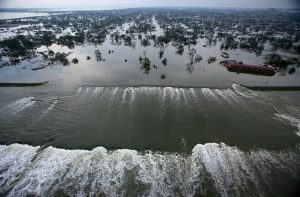Death, destruction, and devastation – this was how society described the toll that Hurricane Katrina took, after it made landfall in August 2005. 1,800 citizens lost their lives during the storm, and over a million people were displaced. Five years later, the areas that were hit the hardest are still rebuilding, and the pieces left in ruins are finally being put back together.

Levees, schools, and homes were all destroyed in states like Louisiana and Mississippi, and rebuilding has been a slow and tedious process. As a college student, can you imagine the campus being completely covered with water and being sent away to another college where you did not want to be?
This was the case at Xavier University in New Orleans, where President Obama delivered a speech to commemorate the five-year anniversary of the storm. People had serious doubts about the school reopening, but through the dedication of students and the community, the school reopened in just five months. When the University’s President, Norman Francis, spoke he said this of their efforts, “What happened to New Orleans represents the greatest disaster this country has ever had. That we were able to come back in such a short period of time is a credit to the faith, commitment, and passion of our staff and faculty, who put aside their personal losses and problems to make this miracle happen.” To be able to rebuild an entire campus in such a short time exemplifies what can be done to continue rebuilding the area.
While stories of rebuilding and triumph are common in the Gulf region, there is still much to be done. The federal government, as well as local charties, is doing their best to ensure that society can go back to normal. The Department of Housing and Urban Development (HUD), for example, has provided permanent housing to over 30,000 families stuck in disaster housing and have helped stabilize communities that were in pain from foreclosures and abandonment. This is crucial because the economy and people’s lives need to be lifted. Without a home, people are forced to live with family or in the trailers provided by FEMA.
The efforts of thousands have helped rebuild many communities. Yet five years later, 176 families from Mississippi and 707 families from Louisiana are still living in FEMA trailers.
With the current efforts being made, they will soon be able to restart their lives in the areas they used to love.
If one were to travel to New Orleans today, he would see over-grown lots and tattered houses with “for sale” signs lining certain roads. This is due in part to limited resources, resulting in families unable to travel back to the area. They were forced to relocate and are now unable to get back to their homes. Another issue plaguing the area is that families have come back to see their homes destroyed. Some families have made the executive decision to move on, because rebuilding their home would result in financial ruin. They had no other choice but to sell the property.
Society, and the people directly affected, will never be able to forget the terror that Hurricane Katrina bestowed upon the Gulf Coast five years ago. We now know people’s dedication and resilience will continue to rebuild the lives and homes of those who lived there. As the five-year anniversary has come and passed, local music and block parties have shown that hope remains in places like New Orleans, Louisiana. The levees may have broken, but Hurricane Katrina will never be able to break the spirits of those involved with the rebuilding process.







